The common clownfish, sometimes called the False Percula or Ocellaris Clownfish is the most popular species of clownfish for saltwater aquariums. This hardy species of clownfish readily adapts to aquarium life, but most are captive bred. This is because wild caught species of clownfish are more expensive then tank raised clownfish. The False Percula Clownfish makes an excellent first fish for any saltwater aquarium because they rarely hide and are less sensitive to changes in water parameters. The absolute minimum tank size for two Ocellaris Clownfish is a 10 gallon nano aquarium, but a 20 gallon aquarium or larger will be easier to maintain.
Clownfish Breeding
When in captivity, most species of clownfish will readily pair off. If purchased together as juveniles, the more dominant one will become the larger female and the smaller will become the male. If for some reason the female were to die, the male would turn into a female and another smaller clownfish could be added to the saltwater aquarium. It is not uncommon for clownfish to lay eggs and for the eggs to hatch in captivity, but rarely do any of the baby clownfish survive. Most are eaten by corals and other tank inhabitants.
Clownfish & Anemones
Your clownfish should readily take most forms of food including pellet and frozen. Some of the best frozen foods for clownfish are mysis shrimp and enriched brine shrimp. Feed your clownfish once or twice a day. If you have an anemone, the fish might attempt to feed it. Some of the best anemones for clownfish are Bulb, Bubble, Long Tentacle and Sebae anemones. These species are the hardiest species of anemone that will host clownfish. The most common anemone available is the Condylactis anemone, but few species of clownfish will use it. These other species of anemone will require more intense saltwater aquarium lighting like power compact, T5, metal halide or LED to survive. Please note that a clownfish does not need a sea anemone to survive and a sea anemone does not need a clownfish to live.
Sea anemones provide a safe place for clownfish to live. You will notice them rubbing against the anemone’s tentacles to clean their skin. You should also be aware that anemones can move, so be sure to have all pumps and powerheads covered. That way your anemone doesn’t accidentally get sucked up or end up clogging your overflow. Most species of clownfish will become territorial around the area of their anemone and will often harass other fish. They may also nip at your hands when your cleaning the fish tank.
Clownfish Species
Beyond the Ocellaris Clownfish, there are several other species of clownfish available for your saltwater aquarium. Some of the other popular species include the Tomato, Clarkii, Maroon, Black Ocellaris, True Percula and Skunk Clownfish. Most species come from islands in the Pacific Ocean like Kupang, Phillipines, Bali, Indonesia and Jakarta. Most are collected by divers who use an underwater vacuum, other cyanide collection still occurs. From there the fish sit on a boat and then are packed in plastic bags and shipped to the United States in an airplane. Most aquarists prefer to purchase captive bred clownfish because they are less susceptible to disease and they don’t have to worry about cyanide collection.
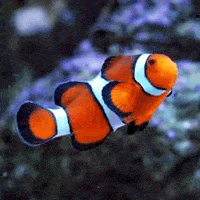 The Ocellaris Clownfish, also known as the False Percula Clownfish, False Clown Anemonefish, and Anemone Demoiselle, is found associating with anemones throughout the Indo-Pacific. It can attain a length of 3.2″ (8 cm) in the wild, but aquarium specimens rarely exceed 2″ (5 cm) unless they are imported large. This fish is sometimes sold as the Percula Clown, even though it is not. The color pattern is very similar, but it is not as bright orange. The black outlines on the white stripes are also thinner on the Ocellaris Clown when compared to the Percula. The advantage of the Ocellaris is that it is much hardier.
The Ocellaris Clownfish, also known as the False Percula Clownfish, False Clown Anemonefish, and Anemone Demoiselle, is found associating with anemones throughout the Indo-Pacific. It can attain a length of 3.2″ (8 cm) in the wild, but aquarium specimens rarely exceed 2″ (5 cm) unless they are imported large. This fish is sometimes sold as the Percula Clown, even though it is not. The color pattern is very similar, but it is not as bright orange. The black outlines on the white stripes are also thinner on the Ocellaris Clown when compared to the Percula. The advantage of the Ocellaris is that it is much hardier.
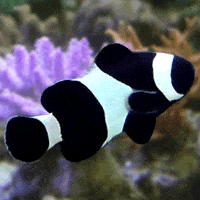 The Black and White Ocellaris Clownfish, also known as the Black Perc, Black Percula Clown Anemonefish, or Black and White False Percula Clown and is normally found in association with anemones on the reefs of the Coral Sea. It can be found individually, or more commonly, in pairs or small groups within the same anemone such as Heteractis magnifica or Stichodactyla mertensii. These tank bred clownfish grow to a maximum size of 3 inches in the aquarium, and may be kept singly or in groups.
The Black and White Ocellaris Clownfish, also known as the Black Perc, Black Percula Clown Anemonefish, or Black and White False Percula Clown and is normally found in association with anemones on the reefs of the Coral Sea. It can be found individually, or more commonly, in pairs or small groups within the same anemone such as Heteractis magnifica or Stichodactyla mertensii. These tank bred clownfish grow to a maximum size of 3 inches in the aquarium, and may be kept singly or in groups.
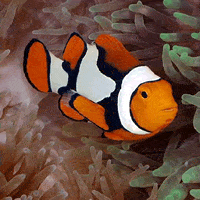 The True Percula Clownfish is the fish most people picture when they imagine a marine aquarium. With their bright orange body color, divided by bands of elegant white outlined in black, Amphiprion percula is the essence of beauty. However, it is the famous symbiotic relationship the True Percula Clownfish has with various anemones that truly captures the imagination of most aquarists. In the wild, True Percula Clownfish is commonly associated with anemones such as Heteractis magnifica or Stichodactyla mertensii. However, in the home aquarium the True Percula Clownfish can do fine without an anemone partner.
The True Percula Clownfish is the fish most people picture when they imagine a marine aquarium. With their bright orange body color, divided by bands of elegant white outlined in black, Amphiprion percula is the essence of beauty. However, it is the famous symbiotic relationship the True Percula Clownfish has with various anemones that truly captures the imagination of most aquarists. In the wild, True Percula Clownfish is commonly associated with anemones such as Heteractis magnifica or Stichodactyla mertensii. However, in the home aquarium the True Percula Clownfish can do fine without an anemone partner.
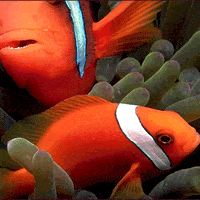 The Tomato Clownfish, also known as the Bridled Clownfish or Red Clownfish, is found throughout the Pacific, almost always in association with an anemone such as Bubbletip Sea Anemone (Entacmaea quadricolor). The Tomato Clownfish has a wider distribution than the Fire Clown, which is usually restricted to the Indo-Pacific reefs. It has also been known to use coral as a host in the absence of an anemone.
The Tomato Clownfish, also known as the Bridled Clownfish or Red Clownfish, is found throughout the Pacific, almost always in association with an anemone such as Bubbletip Sea Anemone (Entacmaea quadricolor). The Tomato Clownfish has a wider distribution than the Fire Clown, which is usually restricted to the Indo-Pacific reefs. It has also been known to use coral as a host in the absence of an anemone.
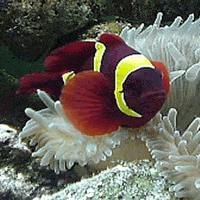 The Maroon Clownfish, also known as the Spine-Cheeked Anemonefish or Maroon Anemonefish, has a bold, red body color with a broad white stripe on the forehead, and white stripes on its midsection and in front of the anal fin. A 30 gallon or larger aquarium is desirable as is a host anemone such as Bubbletip Sea Anemone (Entacmaea quadricolor). It is aggressive towards other clownfish, and they are difficult to maintain together in the same aquarium.
The Maroon Clownfish, also known as the Spine-Cheeked Anemonefish or Maroon Anemonefish, has a bold, red body color with a broad white stripe on the forehead, and white stripes on its midsection and in front of the anal fin. A 30 gallon or larger aquarium is desirable as is a host anemone such as Bubbletip Sea Anemone (Entacmaea quadricolor). It is aggressive towards other clownfish, and they are difficult to maintain together in the same aquarium.
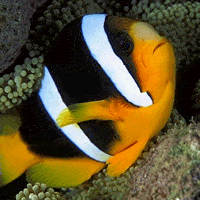 The Clarkii Clownfish is also known as the Clark’s Anemonefish or Clark’s Clownfish. It has a reddish-brown base color with white stripes and an orange forehead when full grown. The juvenile fish are yellowish orange in color with three white stripes on each side of the body. The anal fin is white with a yellow stripe on the top and bottom.
The Clarkii Clownfish is also known as the Clark’s Anemonefish or Clark’s Clownfish. It has a reddish-brown base color with white stripes and an orange forehead when full grown. The juvenile fish are yellowish orange in color with three white stripes on each side of the body. The anal fin is white with a yellow stripe on the top and bottom.
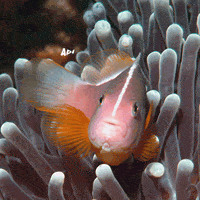 The Skunk Clownfish, also known as the Pink Skunk Anemonefish or False Skunk-striped Anemonefish, has a peach-orange base color with one white stripe behind the head that runs from the nose and down the entire length of the back. Another contrasting white stripe is located just behind the eyes. Clownfish profiles from LiveAquaria, an excellent source for Captive Bred Clownfish.
The Skunk Clownfish, also known as the Pink Skunk Anemonefish or False Skunk-striped Anemonefish, has a peach-orange base color with one white stripe behind the head that runs from the nose and down the entire length of the back. Another contrasting white stripe is located just behind the eyes. Clownfish profiles from LiveAquaria, an excellent source for Captive Bred Clownfish.
